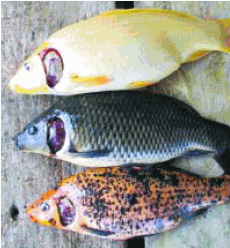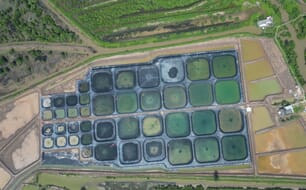
By comparison, the average annual growth rate for capture fisheries was only 1.2 per cent, and for terrestrial farmed meat production systems only 2.8 per cent, over the same period. In 2002, the total world aquaculture production (including aquatic plants) was reported to be 51.4 million tonnes by volume and US$60 billion by value. This represents an annual increase of 6.1 per cent in volume and 2.9 per cent in value, respectively, over reported figures for 2000. Asia produced 91.2 per cent (by volume) and 82 per cent (by value) of global aquaculture production.
DISEASE AS A PRIMARY CONSTRAINT
Like other farming systems, the aquaculture industry has been overwhelmed with a fair share of trans-boundary aquatic animal diseases caused by viruses, bacteria, fungi, parasites and other undiagnosed and emerging pathogens. Disease has thus become a primary constraint to the culture of many aquatic species, impeding both economic and social development in many countries. This situation can be attributed to a variety of multifaceted and highly interconnected factors, such as:
- the increased globalisation of trade in live aquatic animals and their products;
- the intensification of aquaculture through the translocation of broodstock, postlarvae, fry and fingerlings;
- the introduction of new species for aquaculture and fisheries enhancement;
- the development and expansion of the ornamental fish trade;
- the enhancement of marine and coastal areas through stocking aquatic animals raised in hatcheries;
- unanticipated negative interactions between cultured and wild fish populations;
- poor or effective biosecurity measures;
- slow awareness on emerging diseases;
- the misunderstanding and misuse of specific pathogen-free (SPF) stocks (eg shrimps);
- climate change, and
- all other human mediated movements of aquaculture commodities.
SOCIO-ECONOMIC IMPACTS

The frequency of occurrence and the magnitude of spread and effects have prompted many countries to provide estimates of disease impacts. Although very much a grey area in the scientific literature, the impacts of disease have been estimated in socioeconomic terms (eg losses in production, income, employment, market access or market share, investment and consumer confidence; food shortages, industry failure or closure of business or industry).
ADB/NACA (1991) reported that the minimum, conservatively estimated lost farm production in 1990 to fish diseases such as epizootic ulcerative syndrome of fresh and brackish water fishes, penaeid shrimp diseases and a variety of other diseases causing losses in freshwater finfish pond culture and marine cage culture in 15 developing Asian countries was US$1.36 million. At the global level, combined estimated losses in production value due to shrimp diseases from 11 countries from 1987 to 1994 were about $3.01 billion.
At the national level, some estimates of the economic impact of key diseases are that infectious salmon anaemia cost the Scottish farming industry £20 million in the 1998/1999 outbreak, and resulted in a continued annual cost to the Norwegian and Canadian industries of US$11 and $14 million, respectively.
In Thailand, losses due to yellowhead disease and white spot disease of shrimp were estimated at $650 million.
Losses from suspected koi herpes virus in Indonesia amounted to $15 million.
In New South Wales, Australia, some $30 million worth of production was lost due to a single pathogen of rock oyster, Marteilia sydneyi, or QX disease.
Abalone mortalities in Taiwan in 2003 cost the domestic abalone industry $11.5 million.
Economic impacts have also been expressed in terms of the cost of investment in disease research and control and other health management programmes. Some examples from around the world are:
The aquatic animal health research budget for China, Thailand and Norway is around $6, $5 and $50 million, respectively.
Australia’s national plan on aquatic animal health, known as Aquaplan, costs over $4 million for development and initial years of implementation.
The US has budgeted $375,000 per year to develop a national aquatic animal health plan.
Norway spends more than $77 million for overall management of fish diseases covering such aspects as legislation and support to surveillance and control programmes.
Canada allocates $34 million for reactive disease control, where as China spends $73 million on disease control.
A recent report published by the Institute of Aquaculture in Stirling estimated that private sector research and development investment in aquatic animal products is approximately $2.1 million (for antiparasitics) to $8.2 million (for antibiotics), with a global market share worth $29.4 million and $274.4 million, respectively.
Figures remain high, a clear indication of the importance of health management and investments which governments and the private sector is willing to spend to counter production losses.
AGREEMENTS AND INSTRUMENTS ON AQUATIC ANIMAL HEALTH
A number of regional and global instruments exist, either voluntary or obligatory, wholly or partly, which aim to provide certain levels of protection in order to minimise the risks of pathogen/disease incursions associated with the international trade of aquatic animals and their products. (Table 1)
|
TABLE 1. Important treaties and agreements related to international trade in aquatic organisms and their products
|
|
|---|---|
| BINDING | NON-BINDING |
|
|
|
|
|
|
|
|
In the Asia-Pacific region, national strategies on aquatic animal health are either in the process of development or at the initial stages of implementation as part of the implementation of the Asia TGBCIS. These strategies, which contain the action plans of government for the short, medium and long term, follow the concept of “phased implementation based on national needs”.
The National Strategy framework includes important elements such as national coordination, legislation and policy, list of pathogens, institutional resources, diagnostics, health certification and quarantine, surveillance and reporting, disease zoning, contingency planning and emergency response, import risk analysis, quality assurance/quality control, research and development, capacity building, awareness building and communication, farmer/private sector involvement, financial resources, monitoring and evaluation and regional/international cooperation.
Australia has implemented its Aquaplan from 1998 to 2003, and is now on its second five-year implementation, while Canada and the United States are in the process of finalising their national aquatic animal health plans.
DEMAND FOR IMPROVED AQUATIC ANIMAL BIOSECURITY
Aquatic animal health management has recently assumed high priority in many aquaculture-producing regions of the world. Serious socio-economic losses, environmental impacts and the costs involved in disease prevention, containment, eradication and management has stimulated many countries to improve their laboratory facilities and diagnostic expertise, and advance technologies on disease control and therapeutic strategies in order to handle disease outbreaks more effectively.
There has also been some progress in dealing with aquatic animal disease problems in terms of better understanding of risks, increasing awareness, creating effective policy and legislation, enhanced research and manpower development and some capacity to respond to disease emergencies.
There has also been intensified regional and international cooperation, increased networking and better links between various stakeholders, such as fisheries and veterinary authorities and the private sector. However, all these need to be further enhanced in order to match the needs of the rapidly developing aquaculture sector.
Resource protection (aquaculture, wild fisheries and the general environment), food security, trade, consumer preference for high quality and safe products, production profitability, investment and development issues, and new threats of emerging health problems are some of the multiple objectives that will persistently drive the growing demand for aquatic animal biosecurity.
Effective compliance with regionally and internationally agreed instruments, and focussing efforts on prevention, better management practices and maintaining healthy fish may be more important than focussing on why fish get sick. Improving biosecurity, applying risk analysis and using epidemiological approaches will be important tools for disease prevention, control and management.
Health management is a shared responsibility, and each stakeholder’s contribution is essential to the health management process.



